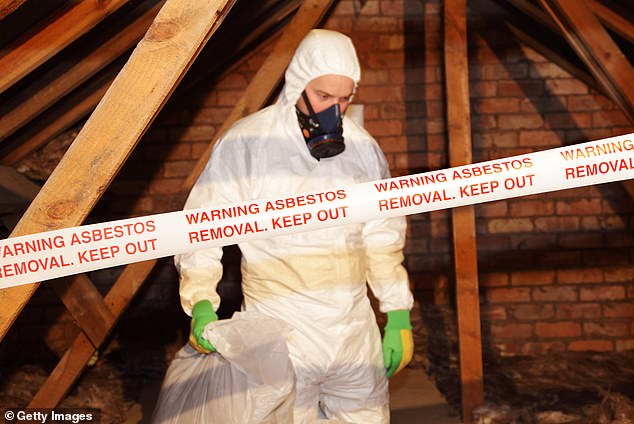The message could not be starker – Britain faces a potential 'tsunami’ of asbestos-related deaths in the years ahead unless action is taken to curb the threat.
That was the warning from a major new report last week which said hundreds of thousands of people could die over the next few decades from exposure to the toxic dust in schools and hospitals.
The report, compiled by the Joint Union Asbestos Committee – a body which lobbies for schools to be stripped of the deadly material – claimed 'ineffective regulations and a cost-cutting culture’ were putting teachers and pupils at risk.
The Mail is now campaigning for public buildings – including more than 21,000 schools – to have all remaining asbestos removed and a national online database to be set up listing every non-domestic building in the country that contains it.
Naturally heat and fire-resistant, asbestos was widely used in public and domestic buildings as a form of insulation and a fire retardant for decades before finally being banned in the UK in 1999, after research found it was linked with a range of incurable diseases.

Britain faces a potential 'tsunami’ of asbestos-related deaths in the years ahead unless action is taken to curb the threat
These include mesothelioma, a deadly form of cancer, which still kills around 2,400 people a year in the UK – nearly 25 years after asbestos use was halted.
’The big problem is we don’t even know where asbestos is – I find it extraordinary that after all these years we don’t have a comprehensive list of public buildings that still contain it,’ says Kevin Blyth, a professor of respiratory medicine at Glasgow University and one of the UK’s leading experts on mesothelioma.
’It will be a huge undertaking to safely remove it, but we just have to get on with it.’
But what exactly is asbestos, what makes it so dangerous – and, crucially, where might it still be lurking? We asked experts to address key questions.
Where does asbestos come from?
Asbestos was first used back in the Stone Age to strengthen ceramic pots.
It’s a naturally occurring mineral that is mined from rocks and soil, then processed into tiny fibres.
These fibres are then compressed to make heat and fire-resistant sheets, lagging for pipes, or mixed with cement to improve its strength.
There are three main types, differentiated by their colour – blue, brown and white.
Blue asbestos was mainly used in spray-on coatings and insulation lagging, but UK imports were banned in 1972 due to emerging health fears.
Brown asbestos was used mainly in thermal insulation up to the late-1960s and in spray form in insulation boards until the 1970s. It, too, was banned in the 1970s.
Finally, white asbestos – the most common form found in Britain’s homes – was for a long time considered the safest type but its use was finally banned in 1999 after it was also found to be dangerous.
Despite being widely banned and its use declining worldwide, asbestos is still used in many countries, including the US. Russia is the world’s biggest producer – churning out about 630,000 tonnes a year – followed by Kazakhstan and China.
Where might it be hiding?
When Britain needed to rebuild much of the country after World War II, asbestos was widely used as an insulation material as it was effective and relatively cheap.
Gradually it was used in everything from domestic fuse boxes, guttering down-pipes and corrugated roofing to vinyl floor tiles, ironing boards and textured ceiling paints (known as Artex).
But there were many more, less obvious, household items packed with the deadly dust.
Hair dryers, toasters and heaters made in the 1950s and 1960s routinely contained asbestos for its heat-resistant qualities.
It grew in popularity until the 1970s when concerns over its safety reduced usage.
But it can still be found in between 210,000 and 400,000 buildings (e.g. factories, schools, hospitals, churches and community centres), according to the Health and Safety Executive (HSE) .
Even vintage Christmas decorations could contain asbestos, as it was sometimes added to fake snow because of its flaky fibrous, white appearance.
Old books may also be riddled with it. Up until the 1950s, many books were bound with the heat-proof material to reduce the risk of them accidentally catching fire.
Vintage books are unlikely to be a serious threat to health unless the binding is damaged – one tell-tale sign that it could contain asbestos is that it is more likely to crumble than tear.

A report last week said hundreds of thousands of people could die over the next few decades from exposure to the toxic dust in schools and hospitals
How does asbestos cause cancer?
If you touch asbestos fibres, there is usually no immediate skin reaction – but if the fibres get trapped in the skin, they can cause calluses.
But the major concern is the fibres can cause cancers if you inhale them.
Normally, tiny hairs that line the airways – called cilia – capture stray organisms that get into the lungs, trapping them so they can be enveloped in mucus and expelled – by coughing – out of the body.
But asbestos particles are so small that they slip past the cilia.
Asbestos is associated with a range of serious illnesses – including lung cancer and asbestosis, a scarring disease of the lungs that can cause shortness of breath, coughing and permanent lung damage. It has also been linked to cases of ovarian and digestive cancers.
But the most serious risk is mesothelioma, a deadly disease that develops in the mesothelium, a protective membrane that covers the lungs, abdomen and heart.
Once the tiny asbestos fibres are inhaled, they pass into the deepest branches of the lungs and then cross into the pleural cavity – an area between the lungs and the chest wall – before nestling into the mesothelium.
The immune system senses something is wrong and repeatedly launches attacks to try to clear the contaminant.
This causes tissue in the mesothelium to become chronically inflamed, which in turn leads to a build-up of harmful calcium deposits (called plural plaques) – creating an environment that’s perfect for cancerous cells to develop and grow.
’These are very small, thin, sharp fibres and they migrate through the lung tissue into
the pleural cavity,’ says John Britton, a professor of epidemiology at Nottingham University and a former consultant in respiratory medicine at Nottingham City Hospital.
’They’re so small they don’t get expelled from the lung as most irritants would when we cough.’
Why do effects take decades to show?
Mesothelioma often develops 30 to 50 years after exposure: the first symptoms are usually chest pain, breathlessness and persistent cough.
It’s common, for example, to hear of people diagnosed in their 50s or 60s who were exposed to the lethal fibres as children when it was their job to shake the dust off their fathers’ overalls at the end of the day, after they had finished work on buildings or in shipyards (asbestos was used extensively in ship building).
The transition to mesothelioma is probably under way within a few years of asbestos fibres penetrating the lungs, says Professor Britton, as they 'will trigger low-level inflammation’.
What’s not clear is how this inflammation then turns cells in the mesothelium cancerous.
Some studies suggest it’s to do with the release of a protein – called HMGB1 – by inflamed and damaged cells, which plays a key role in the proliferation of cancer cells.
Can Mesothelioma be treated?
There are treatments that can slow the rate at which mesothelioma progresses – including chemotherapy, radiotherapy and surgery to remove cancerous tissue – but there is nothing to cure it. Mesothelioma is notoriously difficult to treat because it is usually diagnosed at a late stage and because it can be difficult to get drugs to the site of the tumour.
Professor Britton says: 'It’s a horrible disease. It’s painful and causes extreme breathlessness. There are treatments that delay its progress but nothing that can cure it.’ The average survival time is less than 18 months.

Mesothelioma is notoriously difficult to treat because it is usually diagnosed at a late stage
Newer immunotherapy drugs, such as nivolumab and ipilimumab – which turbo-charge the immune system to attack malignant cells – can extend the three-year survival rate by about 8 per cent.
The UK has the highest rate of mesothelioma cases per head of population in the world – mainly because asbestos use was banned much later here than in other countries (the complete UK ban came in 1999, whereas most Scandinavian countries banned it in the 1980s).
There are around 2,400 new cases every year and about 5,000 asbestos-related deaths – half of them from mesothelioma.
Are there new drugs in the pipeline?
Professor Blyth and more than 100 researchers from 16 countries are investigating new treatments that might be used before the fibres lead to cancer (X-rays and CT scans can pick up the pre-cancerous lesions).
This involves screening tens of thousands of potential drug candidates – including existing medicines for other conditions, in the hope they can be re-purposed.
’My hope is we can find a drug that means we can intervene much earlier and stop mesothelioma from being an invariably fatal disease,’ says Professor Blyth.
Meanwhile, studies are under way in the US to develop a mesothelioma vaccine that could potentially stop the disease from developing in the first place in those known to have been exposed to asbestos fibres and who have precancerous lesions, for instance.
What can I do if it may be in my home?
The HSE says that if asbestos is in your home, it’s most likely to be found in lagging for old pipes or boilers, in cavity walls (as insulation) or in loft spaces.
Pipework lagging is often painted in a protective coating and is one of the most dangerous types, because it is usually blue asbestos, the most deadly.
The slightest disturbance here can release specks of asbestos you could breathe in without even noticing.
So never try and remove it yourself.
If it’s in insulation in the loft, it’s like to be a fluffy material – 'like candy floss’ says the HSE – and blue-grey or whitish in colour.
It’s 'highly dangerous’, it warns, as large amounts of fibres tend to circulate in the air. (It usually came in a 'loose form’ which was spread between rafters by hand. By contrast, modern insulation is with foam sheets.)
If your insulation looks in good condition and undamaged, leave it be, says the HSE.
You could give it a coat of paint (preferably one specifically made for cement products) to seal it and reduce the risk of fibres breaking loose.
But do not sand or drill it – if you think it needs removing, contact a specialist contractor. You can find a list of HSE-approved contractors at: ukata.org.uk.
A 2021 study at the National Institute of Occupational Health in Norway even found power-washing or hosing moss off a garage roof made from asbestos-cement could be dangerous.
It showed it could release harmful fibres into the air – and researchers warned homeowners to leave moss on roofs that might contain asbestos, reported the Journal of Occupational and Environmental Hygiene.
These roofs tend to be corrugated and covered in a thick, grey substance.
Is the asbestos in our water a risk?
According to the Drinking Water Inspectorate – which polices the quality of Britain’s tap water – almost all the water we drink contains asbestos fibres.
That’s because it’s found naturally in rocks in many parts of the country – including Scotland, Northern Ireland and Cornwall – and finds its way into domestic water supplies via rainwater.
But it’s also because hundreds of thousands of water pipes carrying our domestic water supply are made with asbestos cement that is breaking down with age.
Water firms in the UK are not required to monitor asbestos levels and the World Health Organisation claims asbestos
in drinking water is safe as it passes through the stomach – where acid destroys it – not the lungs.
However, at least eight small studies over the years have found a possible link between asbestos levels in water and rates of stomach cancer (a similar number have found no such connection).
Is my child in danger at school?
The Joint Union Asbestos Committee says the toxic substance is not just found around pipes and boilers in Britain’s schools.
’It’s common in columns and wall and ceiling tiles in classrooms and gives off very small, fine fibres which can be breathed in and cause disease many years later,’ it says.
Indeed, the HSE says asbestos in schools can also be released into the air by pupils damaging walls or tiles that contain it, either accidentally or as an act of vandalism.
Previous reports have highlighted how even playing football in a school corridor can unleash harmful amounts of the deadly fibres into their air.
And in 2018, the HSE issued an alert to schools that they may be inadvertently using Bunsen burner mats – used in school chemistry classes to prevent heat damage to surfaces – that are packed with asbestos.
It said the risks to pupils and teachers was small but warned: 'The material is soft and crumbly, and some small particles or fragments may detach on occasions including during use.’
Schools were urged to dispose of any mats safely.
Am I at risk on the London tube?
Asbestos was widely used in tunnel construction on the London Underground from the 1940s to the 1980s and, according to a Freedom of Information response from Transport for London (TfL) earlier this year, it can be found in tunnels on the Victoria, Jubilee and Northern lines. But TfL insists there is no threat to passengers’ health.
Asbestos is also present around platforms and concourses (usually behind wall coverings) and on some older trains that run on the Piccadilly and Bakerloo lines.
However, TfL says it inspects all stations annually to ensure no asbestos has been damaged – or fibres released into the air – and insists dust levels on the Tube that might contain asbestos particles are constantly monitored to ensure they are 'well within’ HSE guidelines.
Wearing a mask while travelling on the underground would not make any difference as the particles are too fine to be filtered out, although an industrial respirator might trap them.

Asbestos was widely used in tunnel construction on the London Underground from the 1940s to the 1980s




